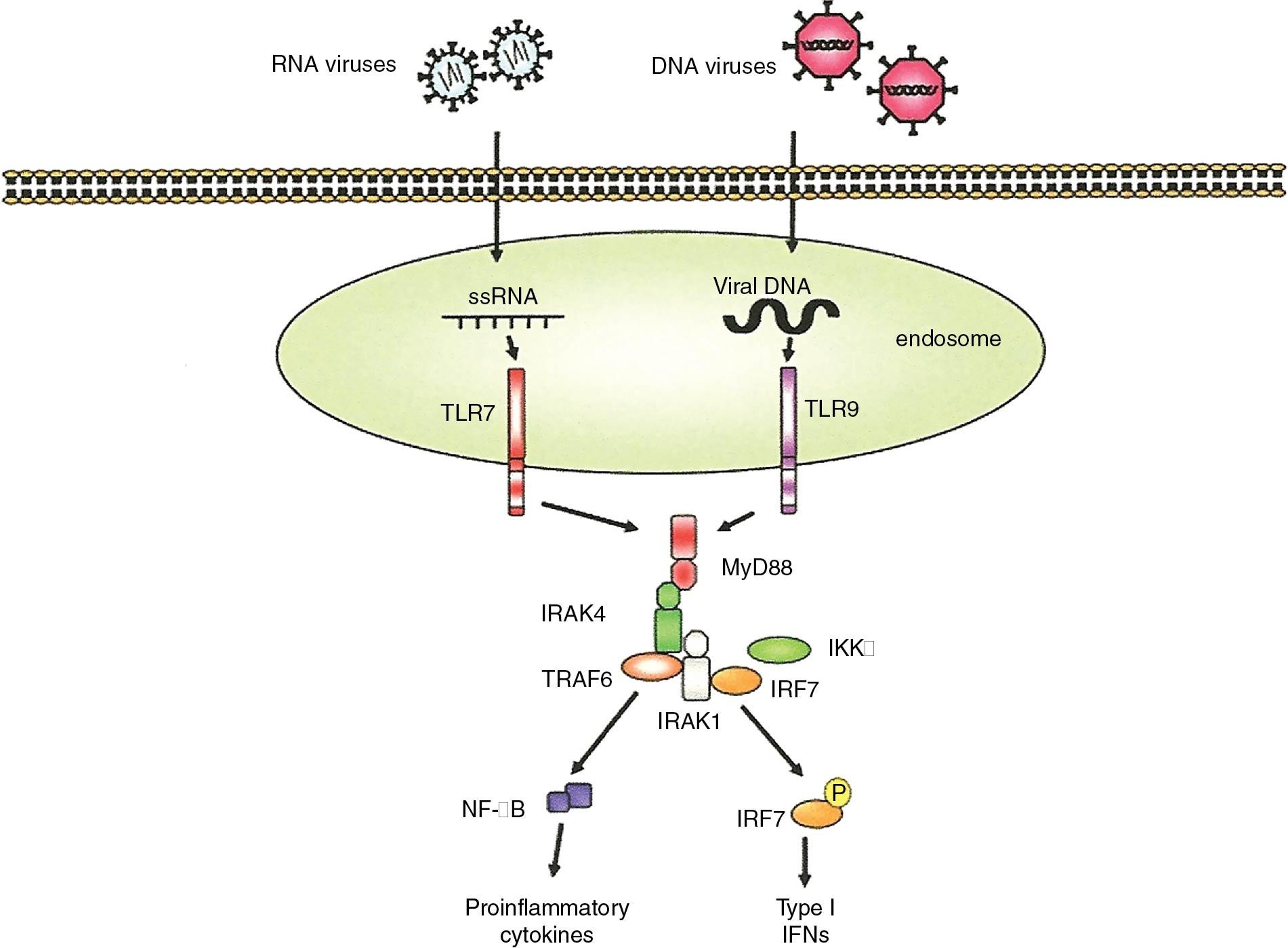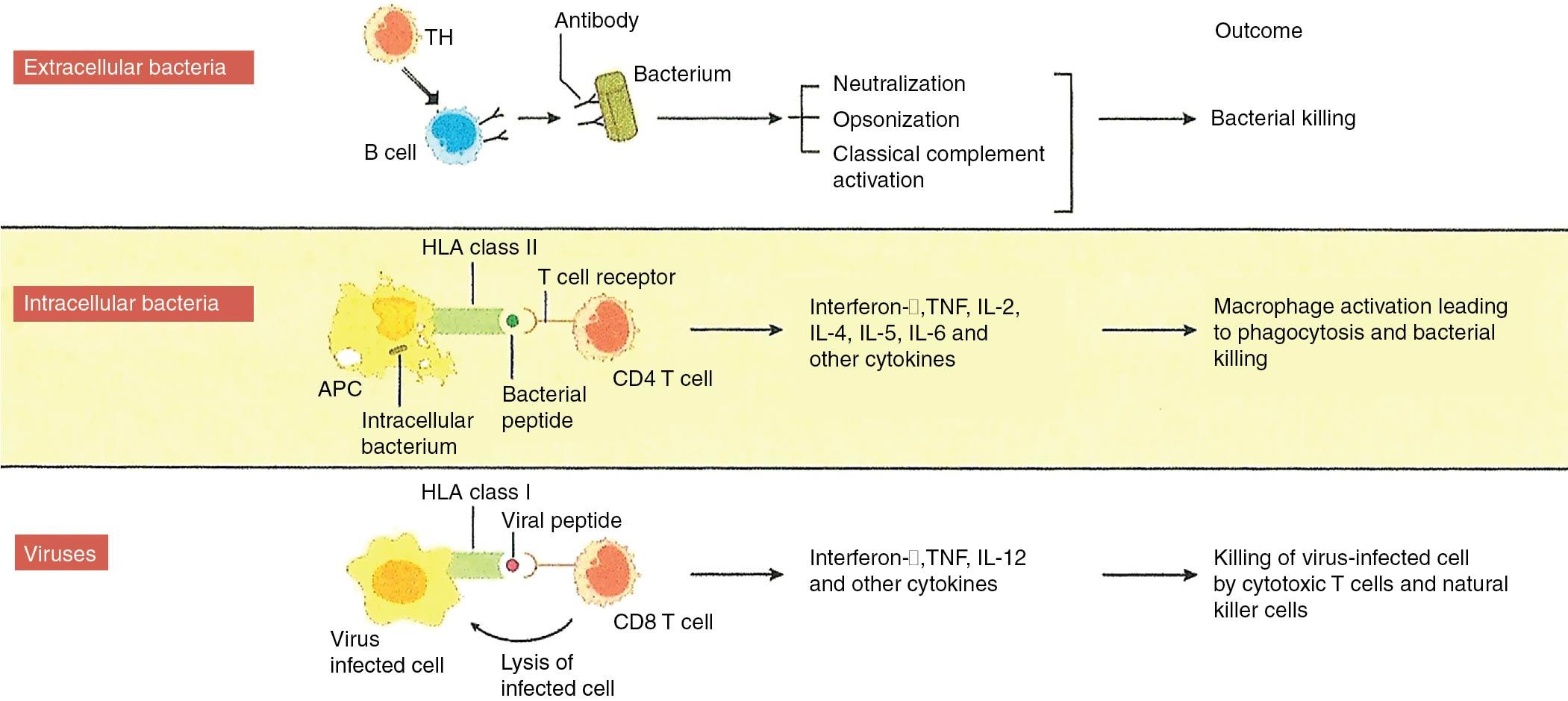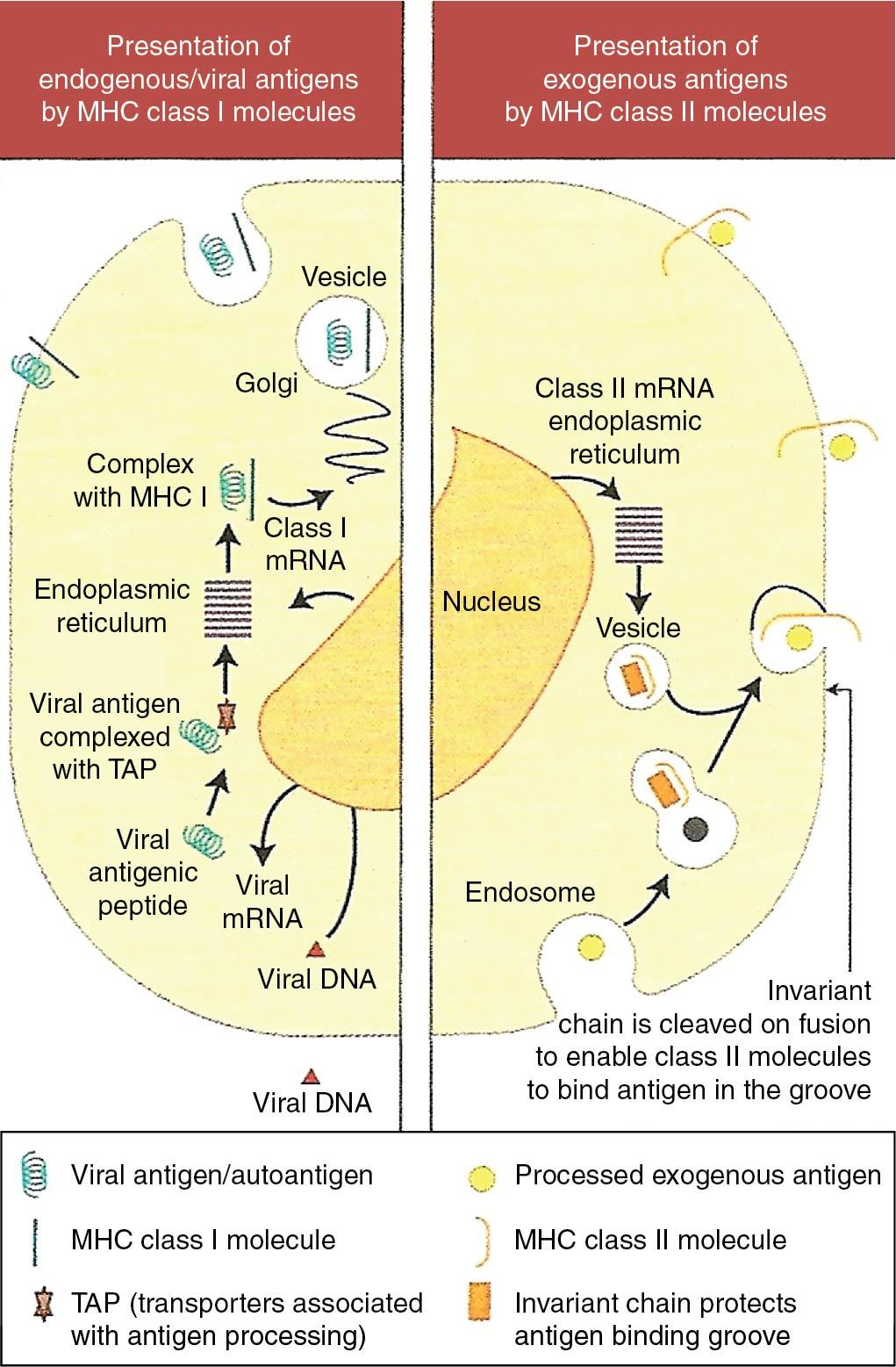Physical Address
304 North Cardinal St.
Dorchester Center, MA 02124
The immune system consists of the innate and adaptive immune systems. The innate system is present at birth and consists of natural barriers, natural killer (NK) cells, macrophages, and the complement system. The adaptive immune system adapts to infection and consists of T and B cells.
The cellular immune response occurs as a result of T lymphocytes reacting via a surface T-cell receptor (TCR) that processes antigens presented to it by an antigen-presenting cell (APC) in conjunction with human leukocyte (HLA) (major histocompatibility complex; MHC) molecules.
T-cell activation can result in activation of helper or inducer (Th) cells, cytotoxic or suppressor T cells , or cytokine production.
Th cells recruit macrophages and cytotoxic or suppressor cells.
Cytotoxic T cells have the ability to lyse infected cells or signal B cells to produce antibody.
Humoral immunity results from antigenic stimulation of a B lymphocyte, which differentiates into a plasma cell and secretes antibody (immunoglobulin).
The complement cascade provides a basis for the inflammatory response and can also mediate cytotoxicity.
Cytokines (lymphokines) are regulatory substances of the immune system produced as a result of T-cell activation caused by cell damage as a result of a virus or other cells, such as macrophages and monocytes, involved in the immune response.
Passive therapy transfers components of the acquired immune system to the recipient with cancer (e.g., monoclonal antibodies directed toward tumor-specific antigens).
Active immunotherapy uses a patient’s own immune system for protection against infection (e.g., vaccines).
Three types of genes are associated with malignant development—oncogenes, tumor suppressor genes, and DNA mismatch repair genes.
Malignant change is seen with point mutations, chromosomal aberration, gene amplification (increase in number of copies), or chromosomal translocation.
Ras oncogenes are part of a group of signal transducer oncogenes that relay messages from the membrane to the cell nucleus. Generally they are activated by point mutations.
Growth factor genes include C-erb-B2 (Her-2/neu), which can be overexpressed and act as a tumor-specific target for monoclonal antibody therapy; these are especially useful in breast cancer therapy.
Nuclear oncogenes include myc and fos and can activate other genes as well as stimulate DNA replication.
Angiogenesis is the formation of new blood vessels, allowing tumors to grow.
Tumor suppressor genes such as Rb and p53 restrain cell growth. They have two copies and, in general, alteration of both copies leads to a mutant expression, which allows tumorigenesis to occur.
BRCA1 and BRCA2 mutations confer a high lifetime risk of breast and/or ovarian cancer. Mutation screening may be appropriate for women with family histories suggesting a hereditary predisposition to breast or ovarian cancer. All epithelial nonmucinous ovarian cancer patients and the majority of breast cancer patients should be offered genetic testing.
DNA mismatch repair genes act by recognizing and fixing errors in the DNA helix resulting from incorrect pairings of nucleotides. They prevent the accumulation of genetically damaged material in the cell.
Cancer develops because of the accumulation of successive and multiple molecular lesions that result in an altered cellular phenotype that is self-sufficient in growth signaling; insensitive to antigrowth signals; and capable of tissue invasion and metastasis, limitless replicative potential, sustained angiogenesis , evading apoptosis , deregulating cellular energetics, genome instability, and avoiding immune destruction ( ). These molecular changes can include overexpression , amplification , or mutation of oncogenes ; the failure of tumor suppressor gene function because of a mutation, copy number loss, deletion, or viral infection; and the inappropriate expression of cytokines , growth factors, or cellular receptors. Also, natural or induced immune responses may play a role in the modulation of cancer growth because immune cells such as tumor-associated macrophages may actually cause tumors to grow. Based on a growing understanding of the immune response, biologic pathways, and cancer development, new immunotherapy and targeted therapies for gynecologic malignancies are being developed and are reviewed and summarized in this chapter.
The immune system has adapted to fight off bacterial or viral infections, but it also plays an important role in the surveillance and control of cancer cell growth. The immune system has two types of responses, innate and adaptive. Innate responses are non–antigen specific, rapid, and do not increase with repetitive exposure to a given antigen . Components of the innate immune system include physical barriers such as epithelial surfaces, macrophages, natural killer (NK) cells, neutrophils, dendritic cells, and components of the complement system. Dendritic cells and macrophages are phagocytic cells that act as antigen-presenting cells (APCs). Macrophages also play an important role in the production of cytokines. Innate immune system forms the initial immune response to invading pathogens and contributes to adaptive immunity, which is composed of T lymphocytes (T cells) and B lymphocytes (B cells) that are involved in cell-mediated immunity and humoral immunity , respectively.
In contrast to the adaptive immune system, which can recognize a variety of foreign substances, including tumor antigens, the innate immune system can only recognize microbial substances. For the most part, neutrophils, macrophages, NK cells, and dendritic cells are involved in the innate immune response and depend on the recognition of pattern recognition receptors (PRRs), which are encoded in the germline and identically expressed by effector cells. These receptors recognize pathogen-associated molecular patterns (PAMPs), which are expressed by microbes and trigger intracellular signaling cascades that result in inflammation and microbial death. PRRs are expressed constitutively in the host and are not dependent on immunologic memory ( Fig. 27.1 ). Toll-like receptors (TLRs) are PRRs that stimulate type 1 interferon (IFN) production, which has antimicrobial, antiviral, and anticancer activity ( ). TLR agonists are being evaluated for use as vaccine adjuvants in immunotherapy trials for ovarian cancer. NK cells are a subset of the lymphocyte population, can directly kill infected cells, and recognize cells that lack major histocompatibility complex (MHC) class I molecules, such as bacteria ( ). Moretta and colleagues have reported that NK cells are cytotoxic to tumor cells, probably because of a similar lack of MHC class I molecules ( ).

The complement system plays an important role in the innate immune system and is a complex system consisting of a large group of interacting plasma proteins. Activation by binding to antigen-complexed antibody molecules activates what is termed the classical pathway. In contrast, the alternative pathway is activated by recognition of microbial surface structures in the absence of antibody. Activation of these pathways leads to cleavage of C3 protein into a larger C3b fragment that is deposited on the microbial surface, leading to complement activation of C3a, which serves as a chemoattractant for neutrophils. Complexing of downstream complement proteins C6, C7, C8, and C9 produces a membrane pore in tagged cells that ultimately results in cell lysis. Unfortunately, tumor cells are often resistant to complement-dependent cytotoxicity. The innate immune system is intricately linked to the adaptive immune system by activated macrophages that enhance T-cell activation and complement fragments that can activate B cells and antibody production.
In humans, B cells are derived from hematopoietic stem cells and aggregate in the lymph nodes, gastrointestinal tract, or spleen. B lymphocytes synthesize antibodies in response to an activated CD8 + cell or helper T cell (Th2). B lymphocytes then differentiate into plasma cells that secrete large quantities of antibody ( immunoglobulin ) in response to an antigen. Unlike T cells, B cells recognize antigens in an unprocessed state. Each B cell is programmed to secrete a specific type of antibody, and it is estimated that more than 10 7 different antibodies are capable of being produced in response to the presence of foreign antigens ( Fig. 27.2 ).

Overall, antibodies have the same basic structure, except for extensive variability in the portion of the structure binding to the specific antigen. Two identical heavy and light chains comprise the basic immunoglobulin (Ig) structure. Each pair is connected by a disulfide bond. Both the heavy and light chains have a variable (V) region at the amino terminus and a constant region (C) at the carboxy terminus. The V region participates in antigen recognition and confers specificity, and the C region enables the antibody to bind to the phagocyte. Five Ig molecules (IgG, IgM, IgA, IgD, and IgE) exist and serve different effector functions. Early in the antibody response, IgM and IgD production occurs and the membrane-bound forms of IgM and IgD bind antigen and activate naïve B cells, leading to B-cell proliferation and clonal selection. IgM is also involved in the activation of the classical pathway of the complement system. Later in the antibody response, the IgG response develops. IgG has a higher specificity for particular antigens and is also responsible for neonatal immunity in the transfer of maternal antibodies across the placenta and gut. Also, IgG causes opsonization of the antigen for phagocytosis by macrophages and neutrophils, as well as activation of the classical pathway of the complement system. NK cells and other leukocytes can bind to IgG- and IgE-coated cells to facilitate antibody-dependent cytotoxicity. IgE mediates hypersensitivity reactions, and IgA is responsible for mucosal immunity.
T cells originate in the bone marrow, differentiate in the thymus, and then circulate in the blood or are harbored in the lymph nodes, spleen, or Peyer patches of the intestine. In contrast to the humoral response, the cellular immune response ( cellular immunity ) depends on direct cell-cell contact. Although antibodies and B-cell receptors may recognize multiple types of antigens, T cells are restricted to peptide antigens and only recognize peptide sequences in the context of membrane-bound host proteins called MHC molecules ( Fig. 27.3 ).

There are two classes of MHC molecules. Each class presents antigens to different populations of T cells and is responsible for various functions in the cellular immune response. Th cells (which are CD4 + ) respond to antigens bound to class II MHC molecules to secrete cytokines that stimulate the proliferation and differentiation of T cells, other B cells, and macrophages. Class II MHC molecules are expressed primarily by professional APCs, which present phagocytosed and processed extracellular peptides to Th cells.
There are two subsets of Th cells, which differ in their cytokine profiles and elicit different responses. Th1 cells secrete interleukin (IL)–2 and IFN-gamma (IFN-γ) to elicit a cell-mediated inflammatory response. Th2 cells secrete IL-4, IL-5, IL-6, and IL-10 to promote antibody secretion and the humoral response. Although both types are involved in most immune responses, they regulate the magnitude of each through mutual inhibition of cytokine production such that Th2 cell cytokines suppress production of Th1 cell cytokines and vice versa.
Unlike class II MHC molecules, class I MHC molecules are expressed by all nucleated cells in the body and are used to present intracellular peptides for surveillance to circulating cytotoxic T lymphocytes (CTLs). CTLs are also known as CD8 + T cells and directly destroy cells that express foreign antigens that arise after a viral infection or are expressed as a result of tumorigenesis. Therefore CTLs are considered to be primarily responsible for the antitumor immune response. Zhang and colleagues reported that the presence of intratumoral T cells was associated with improved progression-free and overall survival in ovarian cancer patients ( ). This association was confirmed by Sato and colleagues, who documented a survival advantage in patients with a higher CD8 + /CD4 + ratio of intratumoral cells in ovarian cancer patients ( ). Pedersen and associates have successfully treated six platinum-resistant ovarian cancer patients with an infusion of tumor-infiltrating lymphocytes preceded by lymphodepleting chemotherapy and followed by decrescendo IL-2 ( ). Another adoptive immunotherapy strategy is the adoptive transfer of genetically modified T cells, such as chimeric antigen receptor (CAR)–expressing T cells. There are ongoing phase I trials using CAR-T targeting mesothelin (NCT03608618), MUC16 (NCT02498912), and NY-ESO-1 (NCT01567891).
A third class of T cells, regulatory T cells (Tregs), are CD4 + T cells that are present in the peripheral circulation, inhibit immune responses, and prevent autoimmunity. Because most tumor-associated antigens are self-antigens, recognition by immune effector cells is regulated by Tregs through peripheral tolerance. High numbers of Tregs have been found in the peripheral blood of patients with epithelial ovarian cancer, and Tregs preferentially accumulate in the tumor environment, such as ascites and ovarian tumor islets. Curiel and associates have shown that high levels of Tregs are found to be predictive of poor overall survival in a cohort of 70 patients with ovarian cancer ( ). Based on these data, a goal of immunotherapy is to eliminate Tregs with the aim of enhancing innate antitumor immunity, which may be achieved with the use of low-dose cyclophosphamide ( ).
Cytokines are proteins secreted by immune cells that are produced in different phases of the immune response to control its duration and extent. During the activation phase of the immune response, cytokines stimulate growth and differentiation of lymphocytes, whereas in the effector phase of the immune response, they activate other effector cells to help eliminate antigens and microbes. The major classes of cytokines include those that regulate innate immunity, regulate adaptive immunity, and stimulate hematopoiesis.
Interleukins are potent cytokines produced by some leukocytes to affect other leukocytes. IL-1 is released in response to cell damage by macrophages, endothelial cells, and some epithelial cells. Although IL-1 has actions similar to those of tumor necrosis factor (TNF), it lacks the ability to cause septic shock symptoms. Macrophages can secrete a variety of ILs. M1 macrophages secrete IL-12, IL-18, IL-23, IFN-γ, and TNF-alpha (TNF-α) and promote immune responses against tumors and intracellular microbes. IL-12 plays an important role in the transition between cell-mediated immunity and adaptive immunity. IL-12 stimulates NK cells and T cells to produce IFN-γ, which activates macrophages to kill phagocytosed foreign substances; IL-12 also increases cytolytic activity by stimulating CD8 + cells. M2 macrophages produce vascular endothelial growth factor (VEGF), IL-6, IL-10, and prostaglandin E2, all of which have immunosuppressive functions and are found selectively in established tumors. The other ILs stimulate NK and T-cell activation and proliferation and IFN-γ synthesis.
Chemokines are small secreted proteins that are part of the largest known cytokine family. There are approximately 47 peptides and 19 G protein–coupled receptors in humans. Functionally, chemokines released in response to stimuli that cause leukocyte recruitment are considered to be inflammatory, whereas chemokines that cause migration of leukocytes to lymphoid organs are considered to be homeostatic. Chemokines affect tumor establishment in the following ways: determining the extent and type of leukocyte infiltration, promoting angiogenesis, controlling site-specific metastasis, and affecting tumor cell proliferation. Chemokines have been classified into four main subfamilies: CXC, CC, CX3C, and XC. The CXC chemokines (CXCL9, CXCL10, and CXCL11) are induced by IFN-γ and are typical chemoattractants of NK cells ( ; ). In ovarian cancer patients, the expression of CXCR4/CXCL12 correlates with decreased progression-free and overall survival ( ; ; ). Because of the importance of chemokines in gynecologic and other malignancies, CXCR4 inhibitors such as peptide antagonists and neutralizing antibodies have been tested in phase I trials (NCT02179970).
Type 1 IFNs, IFN-α and IFN-β, are stimulated by intracellular TLRs and mediate the early innate immune response to viral infections. These cytokines inhibit viral replication, increase expression of class I MHC molecules, and promote a Th1 cell–mediated immune response by promoting T-cell proliferation and NK cell cytolytic activity. IFN-γ, a type II IFN, is principally responsible for macrophage activation and the effector functions of innate and adaptive immune responses.
In addition to IFN-γ and transforming growth factor beta (TGF-β), IL-2, IL-4, IL-5, and IL-13 are all involved in the regulation of adaptive immunity. After antigen recognition, the T cells produce IL-2, which causes clonal expansion of activated T cells and additional production of cytokines such as IFN-γ and IL-4. IL-2 stimulates antibody synthesis and B cells by acting as a growth factor. IL-4 not only promotes IgE production from B cells but also stimulates the development of Th2 cells from naïve T cells. IFN-γ is produced by T cells in response to antigen recognition or by NK cells in response to microbes or IL-12. IFN-γ activates the microbicidal function of macrophages, stimulates the expression of class I and II MHC and costimulatory molecules by APCs, promotes the maturation of cells expressing CD4 into Th1 cells, and inhibits the Th2 cell pathway, thereby effectively promoting a cellular immune response. TGF-β inhibits the proliferation of and differentiation of T cells and contributes to immune evasion of tumor cells by inhibiting antitumor host immune responses.
Become a Clinical Tree membership for Full access and enjoy Unlimited articles
If you are a member. Log in here